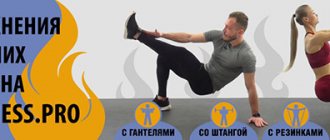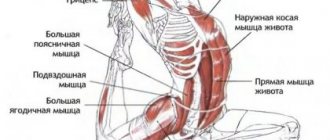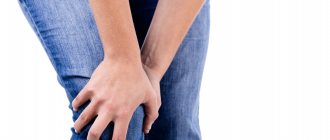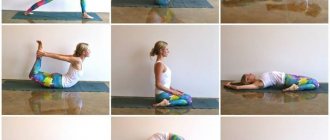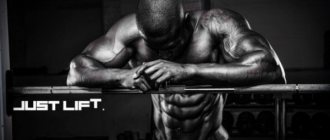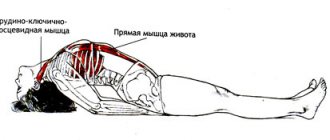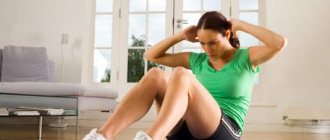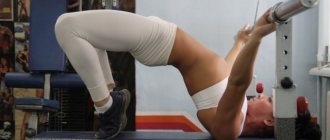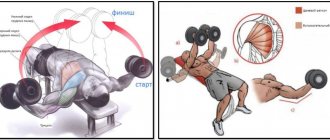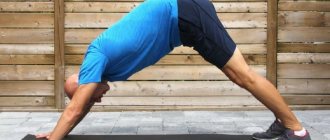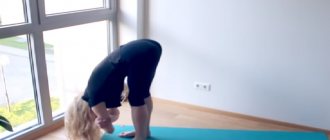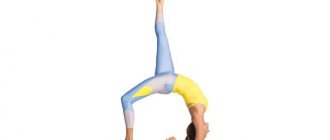Execution technique
Step 1:
Lie on the floor, placing a folded blanket under your shoulders to protect your neck if necessary. Bend your knees, pull your feet as close to your sit bones as possible (you can use your hands to pull your feet as close to your pelvis as possible).
Feet parallel to each other, toes pointing straight ahead. Hands lie on the floor along the body, palms down.
Step 2:
Exhale and, pushing your tailbone towards your pubis, lift your pelvis up. Keep your hips and knees parallel to each other . Feel the stretch forward across the entire front of your thighs. Lift your pelvis up until your thighs are parallel to the floor.
Step 3:
Leaning on your shoulders, place your hands under your buttocks and clasp your palms together, stretch your arms further towards your feet. Don't strain your neck - the weight should be on your shoulders. Having strengthened your arms, expand your shoulder blades and try to lift up the space between them and at the base of your neck.
Step 4:
Stay in the pose for 30 seconds to 1 minute.
Adjustment of asanas / control points
- when bending, push both the tailbone and shoulder blades up. Imagine that your shoulder blades are a pair of arms lifting your chest up.
- open your chest by moving your shoulders outward (stretch them to the sides and twist them inward);
- do not strain your buttocks , arch by pushing your tailbone up;
- do not spread your knees to the sides, but also do not connect them together - your hips and knees should be strictly parallel to each other;
- if you feel discomfort in your knees when stretching upward, stop at the height at which you feel comfortable, do not allow pain ;
- When entering the asana, do not turn your head to avoid neck injuries .
Where is it better to exercise - at home or with a trainer?
If you are just starting to practice yoga, then be sure to hire a trainer - this is an important condition. He will explain to you the basic provisions and details of implementation, on which your future condition depends. That is, if the execution technique is violated, you will not be able to achieve the effect of calm and self-understanding. And after that, you can move on to home exercises.
Benefit
- expands the thoracic spine;
- stretches the neck and spine;
- stimulates the abdominal organs, lungs and thyroid gland;
- tones the legs: relieves fatigue and heaviness in the legs;
- improves digestion;
- helps relieve menopausal symptoms;
- relieves menstrual discomfort, practiced instead of inverted poses and backbends;
- relieves back pain, headaches;
- calms the mind, helps relieve stress and improves mood;
- reduces anxiety, fatigue;
- indicated for the treatment of asthma, high blood pressure, osteoporosis and sinusitis.
Short description
Yoga is an ancient Chinese practice that will immerse you in the world of antiquity and make you feel unity with nature and yourself through various exercises. People who truly appreciate the wonderful world of yoga forever renounce all the benefits of civilization and go into the spiritual world.
Gradually, after starting classes, the desire to give up bad habits and everything else will overtake you on its own. It can take years to find balance within yourself.
Some people perceive yoga as a series of asanas. After this, don't be surprised if it becomes a regular exercise for you to get rid of physical fatigue. Thus, it will not bring the desired effect.
Indications
Plunge into the world of yoga if you are very tired of the fast pace of life, if you cannot find the strength to carry out daily activities. After a couple of sessions and correct perception, you will be able to get rid of spiritual and physical stress.
Yoga is also recommended for people suffering from depression. Many, after completing a course of this type of therapy, began to feel noticeably better and react less to external facts that previously had a negative impact on them.
Benefit
Many people still do not know about the real benefits of this technique for the body and head. It can be safely used for additional treatment. These exercises will help you forget about the pain brought by chronic diseases. Also, by starting to practice yoga, you will forever get rid of diseases associated with the musculoskeletal system. For example, lion pose helps with sore throat. Even a child can do it.
Yoga is very important for the female half of the world's population. Many people ask: how do inverted poses affect women's health? The answer is simple - during their execution, blood flow in the lower part of the body increases. This way, it will be easier for her to get pregnant, and she will be able to get rid of diseases associated with the genitourinary system.
Contraindications and possible harm
You need to understand that you can do any exercises that you like, but due to certain circumstances, their implementation may be strictly contraindicated.
Therefore, it is better to familiarize yourself with the contraindications in advance than to encounter complications during or after the lesson:
- You cannot do yoga if you have a mental disorder. For example, if you suffer from schizophrenia.
- If you have internal injuries.
- Forget about exercising if you suffer from intracranial or blood pressure.
- If you have hernias.
- If you have recently experienced a heart attack. You can start training only after six months, but only after consulting your doctor.
- If you have joint pain, have experienced spinal injuries, or cancer.
- If you have recently had surgery. The seams can come apart at any time.
- It is important to stop exercising while you are sick. For example, acute respiratory viral infections, acute respiratory infections, etc.
Even if you do not fall into the category of people described above, but during exercise you feel ill, you should immediately stop performing the poses and seek help from a specialist.
Variations
- Light version
For beginners, the arms and shoulder girdle may be weakened, so when entering the asana there may be a feeling that the shoulders are giving way. At this moment, it is very important not to try to pull them too far away from your ears - otherwise you may overtighten and injure your neck. Instead, it's better to raise your shoulders slightly toward your ears and focus on pushing your shoulder blades and spine up toward the ceiling.
- Complicated version — Eka Pada Setu Bandha Sarvangasana (bridge pose with leg raised up)
Perform Setu Bandha Sarvangasana. As you exhale, pull your right leg towards your body and, keeping the weight on the remaining points of support (left foot, shoulders), extend your leg up perpendicular to the floor. Hold the pose for 30 seconds, then exhale and return your leg to the starting position. Repeat the asana with your left leg for the same period of time.
Yoga equipment. Types and application. Peculiarities
Yoga classes do not lose their relevance, so more and more people are joining this movement. To understand all the basics and not harm your own body, the desire to exercise is not enough. To make your workouts easier, you need the right yoga equipment, which you need to choose correctly.
Basic and auxiliary equipment for yoga
When practicing yoga you may need the following supplies:
- Rug.
- Belt.
- Bolster.
- Pillow.
- Bench.
- Blocks.
- Chair.
- Swing.
- Sirshasana props.
- Backbender.
- Wheel.
Most of the equipment listed is optional and is used more by beginners. Such accessories are called props. They help to relax the body in an uncomfortable, unusual position. Using such auxiliary equipment, you can perform asanas better and more correctly. After training and experience, most of the equipment will no longer be needed, with the possible exception of a rug.
Rug
This is the most popular yoga equipment, which is used as a floor lining. All exercises are performed on it. Of course, it is quite possible to do without a mat, but this will create a lot of inconvenience and even pain from contact of the knees, back and other parts of the body with hard surfaces.
A distinctive property of yoga mats is a special type of coating, which allows it not to slip on the floor, and also prevents your arms and legs from slipping when performing exercises. The rug can be made from various natural or synthetic materials. Natural rugs are more expensive, but are not always durable. Rugs are typically made from rubber, latex, cotton, polyvinyl chloride or cork. The thickness of the product can vary from 3 to 6 mm. It is optimal to use a 4 mm mat. It provides sufficient softness and comfort for the knees. Thick mats are heavier, which can be a problem if you have to carry them to the gym by hand. The advantage of thicker rugs is that they better compensate for bulges in the floor.
Belt
A significant part of yoga exercises involves grasping the legs with the hands in various positions. To do this, you need to have body stretching, which beginners do not have. To compensate for this disadvantage, belts are used. They hook onto the legs or various surfaces, after which their ends are pulled up by the hands, thereby providing a deflection of the back, creating forces. The belts are made soft so that they do not rub the body. The longer the belt, the more exercises you can perform with it. The optimal length is 180 cm, which is enough for a person of average height.
Belts can be thrown over various objects and, while sitting on the floor, you can pull them, thereby training flexibility. Almost all trainers use belts when studying asanas to immediately teach the student’s body to bend correctly.
Bolster
This is also a common yoga equipment, which is a roller similar to an elongated pillow. It is placed under the back, creating soft support. This makes the position easier and allows you to stretch the spine. The bolster also helps you relax. It is made from padding polyester, cotton wool or buckwheat husks. It comes in a variety of sizes to suit your body type and exercise.
Pillow
They are used for meditation when you have to sit in one position for a long time. Pillows come in round and square. The size is selected individually according to body parameters. The height of the pillow can also be different. There are products even with a thickness of 12 mm. Usually the pillows are taller, similar to those used for sleeping.
Bench
It is necessary to perform deflections. It is also called the Viparita Dandasana bench, because with its help you can prepare the body and learn how to perform the exercises of the same name. The bench is about 60 cm high and wide. It can be used to stretch your back and relax your spine. The bench can be used to straighten a stoop, as well as treat intervertebral discs and scoliosis. It is believed that the design of the dexterity was invented more than 4,000 years ago. It is usually made of wood. When performing exercises, it is covered with a mat to make the surface softer.
Blocks
They are also called bricks. They are rectangular blocks made of wood, foam or cork. They are used very often when performing a wide variety of exercises. Usually several bricks are used at once. Blocks help you bend over, do proper crunches, and improve stretching. Bricks can be used in almost all asanas. They help in standing, sitting and lying positions. They can be used to support various parts of the body. You can sit on the blocks. The standard size of bricks is 23x12x7 cm.
Chair
This is a less commonly used yoga equipment, since it can be used as almost any home furniture of a suitable size. This could be an ordinary kitchen stool or even an office chair. You can meditate while sitting on a chair, or use it to support your body when doing backbends. The height of the chair is selected according to the height parameters.
Swing
This device is a whole system of tapes made from soft fabric. They have three-level handles designed to secure arms and legs. The swing is fixed to the ceiling with a special hook. By moving on them you can perform various complex exercises that are impossible to do in any other way.
Sirsasana props
This is a specialized device that allows you to comfortably perform a headstand. It consists of two persistent posts with or without soft linings, used to position the shoulders. Also in the design there are two bricks on which hands are removed. When using this device, the head hangs freely, which eliminates pressure on the cervical spine. The entire body weight is supported by the shoulders. This type of yoga equipment can strengthen your muscles by providing a good stretch before you begin to fully load your neck and rest your head on the floor when standing.
Backbender
Typically, such a device is a curved wooden stand that is used to stretch the back. It is suitable for beginners, helping them to bridge and increase their backbend. There are various exercises in which you can use this accessory. It is securely installed and does not wobble, which is especially important if the body does not have good flexibility.
Wheel
It is used to support the body in various poses, thereby replacing blocks, and also helps in bending like a backbender. Using the wheel you can make exercises easier or, conversely, make them more difficult. Wheels can be used to develop a sense of balance. Such yoga equipment is often used to pump up the abs and develop various skills. The wheel is one of the most beautiful accessories. It is customary to decorate it with various patterns and designs.
Related topics:
- Gymnastic equipment. Types and design. Peculiarities
- Equipment for Pilates. Types and application. Peculiarities
